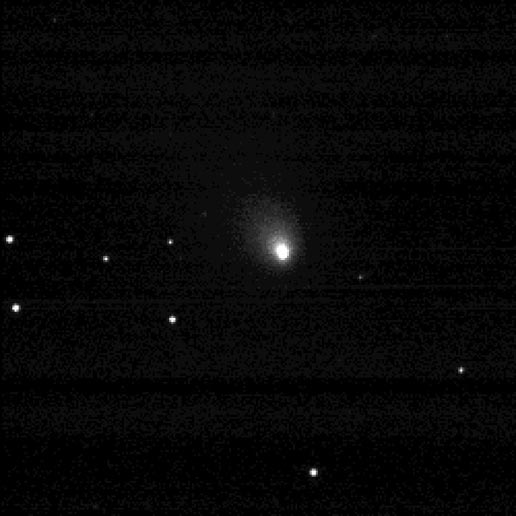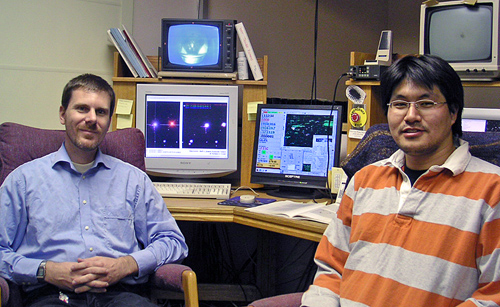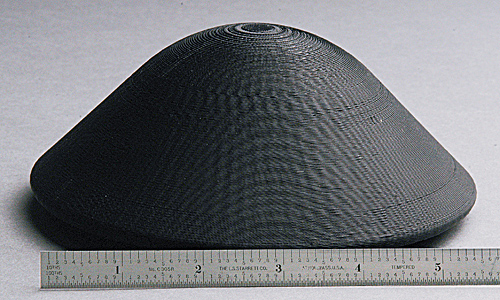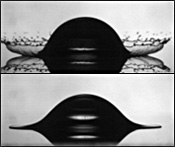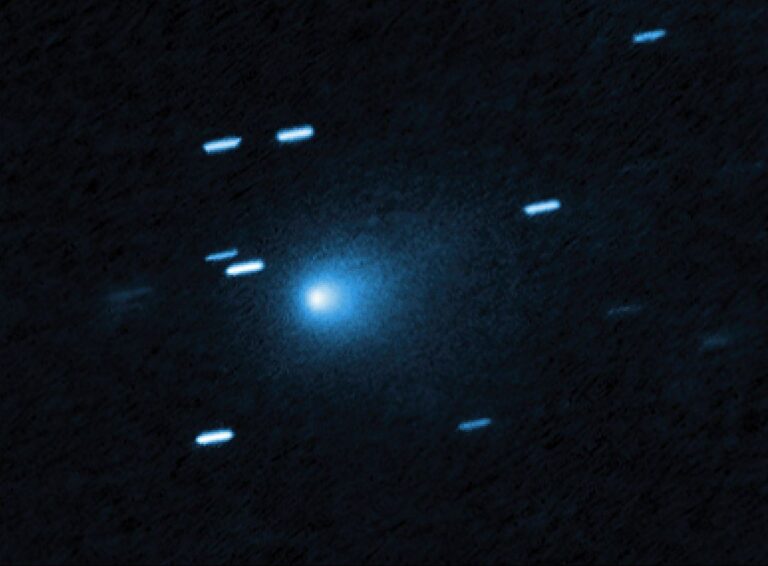Key Takeaways:
Deep Impact spies its target
Earlier this week, NASA’s Deep Impact spacecraft imaged Comet Tempel 1. Captured by the spacecraft’s Medium Resolution Instrument at a distance of about 3.97 million miles, the photograph was taken 69 days before the two meet.
This image, the first Tempel 1 shot captured by Deep Impact, will be followed by thousands of closer views of the comet. The Deep Impact team members will use these images to adjust the collision course. Although project scientists are excited about this initial view from Deep Impact, the best is yet to come.
“With daily observations beginning in May, Tempel 1 will become noticeably more impressive as we continue to close the gap between spacecraft and comet,” says Deep Impact principal investigator Michael A’Hearn. “What is now little more than a few pixels across will evolve by July 4 into the best, most detailed images of a comet ever taken.”
— Jeremy McGovern
How big will it be?
If everything goes as planned, Deep Impact’s projectile should blast into and knock a chuck out of Comet Tempel 1. How big of a chunk remains to be seen, but perhaps you have an estimate.
With their Great Comet Crater Contest, The Planetary Society wants you to guess the size of the hole caused by the July 4, 2005, impact. Contest participants may enter on-line or by mail. Guesses must be made in meters — the web site does include a conversion chart for those unfamiliar with metric. All entries must be received prior to the moment the impactor hits the comet.
The society will award three grand prizes for the best guesses. The winners will be randomly selected from a pool of entrants who guess within 5 percent of the crater’s diameter. The society also will provide 150 runner-up prizes.
Each grand-prize winner will receive Planetary Society membership and a plaque made of the same copper material that comprises the heavy mass of the projectile. Runner-up winners will receive a certificate of recognition and a Deep Impact Spacecraft paper model.
For more information, visit The Planetary Society’s web site. — Jeremy McGovern
Resisting change for 7 billion years
Astronomers have proved that a fundamental constant, which appears in many physics and astronomy equations, is just that — constant — and has remained so for 7 billion years.
The fine structure constant appears in equations describing the spacing between energy levels in atoms. Any change of the constant would force a change in the observed emission spectra. Astronomers at the University of California at Berkeley and the University of California at Santa Cruz used the DEEP2 survey — currently taking data of 50,000 galaxies with the Keck telescopes at Mauna Kea, Hawaii — to collect ionized oxygen emission spectra of 300 galaxies at distances of 4 to 7 billion years ago.
DEEP2 data gave the scientists a precision better than 0.1 out of 5,000 Ångstroms — 1 nanometer is equivalent to 10 Ångstroms — to measure the emitted wavelengths. From the observed wavelengths, they calculated the constant and compared those values with the known value to find the constant had not changed within one part in 30,000.
— Liz Kruesi
Pristine Sedna
Isolation has its benefits. Sedna, the most distant known object orbiting the Sun, appears to have avoided significant collisions with other bodies for millions of years. Recent spectroscopic infrared light studies of the strange planetoid’s surface indicate Sedna has dodged significant bullets. The data also shows Sedna may lack large amounts of water or methane ice.
Astronomers at Gemini Observatory and CalTech observed Sedna using the Near Infrared Imager (NIRI) at Gemini North, atop Mauna Kea, Hawaii. The NIRI data lacked strong spectral lines that would indicate the existence of ice. Further, deeper studies of the planetoid may show limited existence of ice. — Jeremy McGovern
Bots to battle in northern California this Saturday
Robotic teams operated by California middle and high school students will square off this Saturday at Santa Clara University in the Northern California Botball Robotics Tournament.
Botball is an international program sponsored by NASA that encourages engineering, math, science, and technology education. Participating students are given seven weeks to design, build, and program two microcontrolled robots constructed of LEGOs.
Participants compete against each other on a 4-foot by 8-foot playing field in non-destructive matches. Robots are student-built and computer-programmed to maneuver on the game board. Once the game starts, students step back and the robots must start, stop, and play the game by themselves without being guided by remote control.
Upcoming Botball tournaments will be held in New York, Pittsburgh, and Doha, Qatar.
For more information, visit the Botball web site. — Jeremy McGovern
VATT supernova
On April 2, Arizona State University researcher Rolf Jansen and graduate student Kazuyuki Tamura were operating the 1.8m (5.9 foot) Vatican Advanced Technology Telescope (VATT) atop Mt. Graham, Arizona. They turned the scope to MCG +07-33-27, an early-type spiral galaxy undergoing a burst of star formation, as part of a study with collaborator Norman Grogin of Johns Hopkins University. They then captured two 5-minute exposures with the telescope’s CCD camera.
Jansen noticed a conspicuous point-like object a few arcseconds southeast of the galaxy’s nucleus. “It was a typical ‘Hmm, that’s odd’ experience,” he told Astronomy.
The 18th-magnitude object was stationary on images acquired on subsequent nights. It didn’t appear in Sloan Digital Sky Survey images or in an image Grogin took of the galaxy a decade earlier. Jansen and Tamura thought they’d found a supernova and encouraged spectroscopic and photometric follow-up (a PDF finder chart is here).
Chris Corbally, the Vatican Observatory’s vice director, says this is the first supernova discovered with the telescope. “It’s a fun discovery,” he said, “and adds to supernova statistics and distance determination to this galaxy.” (For more on the VATT, see Astronomy‘s March 2005 issue.)
The object was designated SN 2005bk by the International Astronomical Union April 15 (see IAU Circular 8512). Two days later, Mohan Ganeshalingam and University of California, Berkeley, colleagues obtained CCD spectra that confirm 2005bk’s status as a type Ic supernova, about 1 week past maximum light, according to today’s IAU Circular 8514. — Francis Reddy
NASA and The Aerospace Corporation — a non-profit organization in El Segundo, California, that provides technical and scientific research and advisory services to national security space programs — are partnering to develop a “black box” for spacecraft. The widely known device, currently used in airplanes to record speed data, altitude, and crew conversations, will be modified to endure the rigors of space flight and to remain intact in the event of a breakup during reentry.
Black boxes help airplane crash investigators locate the crash site and construct a time line of events that led to the accident.
Scientists will begin work on making the spacecraft model smaller than the aircraft counterpart and protect it with a heat shield. Project scientists will use nanotechnology to construct a highly sophisticated instrument complete with a battery, data recorder, sensors, and transmitter in a compact, inexpensive package. The device will be about 1 foot in diameter and weigh 2.2 pounds — with the heat shield.
Nanotechnology is the creation of materials, devices, and systems through the control of matter on the nanometer scale. A nanometer is one-billionth of a meter, roughly 10,000 times smaller than the width of a human hair. “Nanotechnology could lead to changes in almost everything from computers and medicine to automobiles and spacecraft,” said James Arnold, a scientist with the NASA Ames Center for Nanotechnology in Moffett Field, California.
Dan Rasky, a scientist at NASA Ames Research Center, suggests that the spacecraft black box could be first used on the Crew Exploration Vehicle — a spaceship NASA plans to use to fly astronauts to the moon and beyond. — Matthew Quandt
Exploratorium to display large HST images
On April 26, the Exploratorium, a science center located in San Francisco, will unveil two new large-scale photographs captured by NASA’s Hubble Space Telescope (HST). One image showcases M51 — a spiral galaxy rich with star clusters in its arms. The other photograph exhibits the Eagle Nebula — a gaseous region shaped by ultraviolet light from young, hot stars.
These images will commemorate the Hubble’s accomplishments over the past 15 years. The Exploratorium’s HST celebration will include on-hand experts to discuss the telescope’s career with visitors. If you are unable to make it to the center, you can watch a webcast on the Exploratorium’s site. — Jeremy McGovern
Rovers to punch in for overtime
NASA recently approved 18 more months of service for the twin rovers — Spirit and Opportunity — rolling across Mars. This is the second extension given to the durable explorers. After completing their initial 3-month missions, the rovers received an 11-month extension. The duo will investigate the Red Planet through September 2006 if the rovers stay operational, but that’s a big “if.”
“Either mission could end tomorrow with a random part failure,” explains Jim Erickson, rover project manager. “With the rovers already performing well beyond their original design lifetimes, having a part wear out and disable a rover is a distinct possibility at any time. But right now, both rovers are in amazingly good shape. We’re going to work them hard to get as much benefit from them as we can, for as long as they are capable of producing worthwhile science results.” — Jeremy McGovern
Not under new management
Cornell University will continue to operate Arecibo Observatory, the world’s largest single-dish radio telescope. The National Science Foundation (NSF) has renewed the management contract of Arecibo with Cornell’s National Astronomy and Ionosphere Center (NAIC) for approximately 70 million dollars through March 31, 2010.
Cornell formed the NAIC in 1971 to run the 1,000-foot-diameter (305 meter) Arecibo telescope, located in Puerto Rico.
— Jeremy McGovern
No gas, no splash
At last week’s American Physical Society meeting in Los Angeles, University of Chicago graduate student Lei Xu revealed the surprising key to turning a splash into a splat.
Xu and colleagues investigated how atmospheric density alters the way a liquid drop impacts a smooth dry surface. Under normal conditions, a drop flattens out as it strikes a surface, splays sideways, and then launches a crown of splash droplets upward (see the AVI movie).
But remove most of the surrounding atmosphere, and the splash disappears — the droplet splats and flows evenly across the surface (AVI movie). Xu’s studies show the pressure and makeup of the gas influence the size of a splash, an insight that may bear on many technologies using fluids, such as ink-jet printing or liquid-fuel combustion. Xu’s work provides a technique for controlling splashing precisely.
Titan’s methane rain splashes down, but any liquid drops on Mars won’t — at least not until the planet’s atmospheric pressure becomes an appreciable fraction of Earth’s. Science-fiction writers take note. — Francis Reddy

